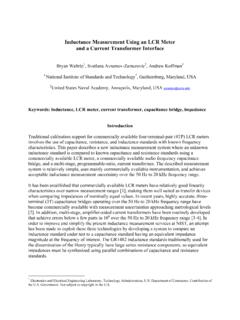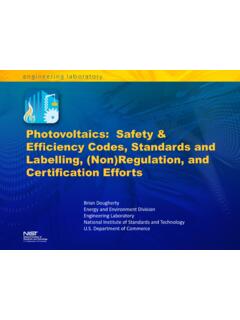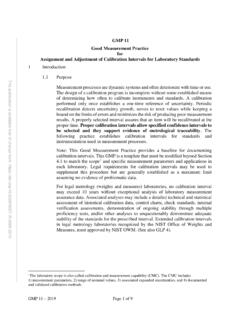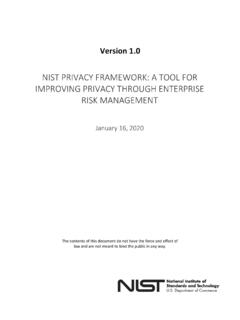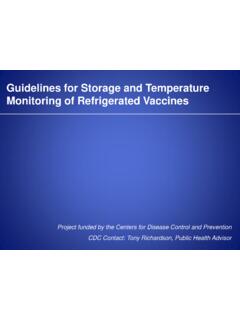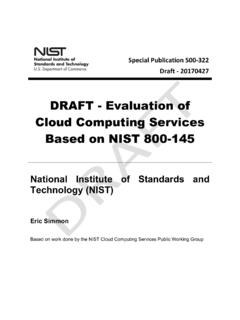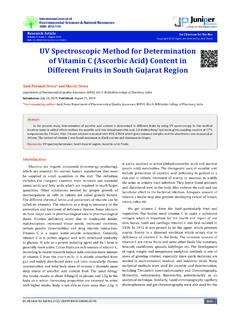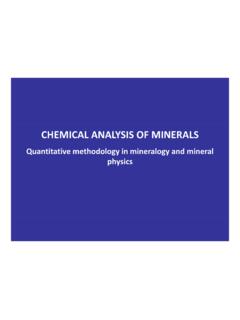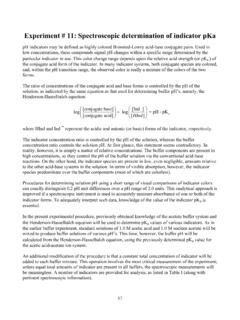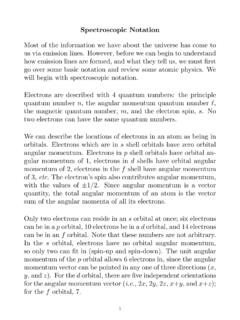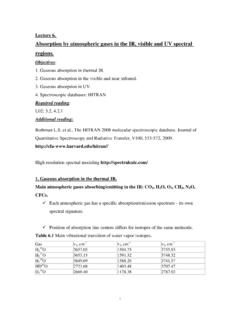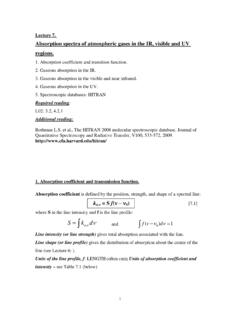Transcription of Handbook of Basic Atomic Spectroscopic Data
1 Handbook of Basic Atomic Spectroscopic DataJ. E. W. C. MartinNational Institute of Standards and Technology, Gaithersburg, Maryland 20899-0001 Received 4 March 2004; revised manuscript received 30 April 2004; accepted 21 May 2004; published online 28 September 2005 2005 American Institute of Physics. DOI: Contents1. Atomic Data Strong Line Persistent Line Transition Energy-Level Classifications.. Energy Level Finding Data Tables for the Elements OrderedAlphabetically ..1564 Actinium Ac ..1564 Aluminum Al.
2 1568 Americium Am ..1573 Antimony Sb ..1577 Argon Ar ..1582 Arsenic As ..1592 Astatine At ..1595 Barium Ba ..1596 Berkelium Bk ..1600 Beryllium Be ..1606 Bismuth Bi ..1609 Boron B ..1614 Bromine Br ..1617 Cadmium Cd ..1622 Calcium Ca ..1625 Californium Cf ..1630 Carbon C ..1634 Cerium Ce ..1640 Cesium Cs ..1652 Chlorine Cl ..1657 Chromium Cr ..1664 Cobalt Co ..1673 Copper Cu ..1679 Curium Cm ..1684 Dysprosium Dy ..1691 Einsteinium Es ..1698 Erbium Er ..1702 Europium Eu ..1708 Fluorine F ..1715 Francium Fr ..1720 Gadolinium Gd.
3 1721 Gallium Ga ..1731 Germanium Ge ..1734 Gold Au ..1739 Hafnium Hf ..1744 Helium He ..1750 Holmium Ho ..1756 Hydrogen H ..1763 Indium In ..1766 Iodine I ..1771 Iridium Ir ..1776 Iron Fe ..1782 Krypton Kr ..1797 Lanthanum La ..1805 Lead Pb .. 1811 Lithium Li ..1816 Lutetium Lu ..1820 Magnesium Mg ..1825 Manganese Mn ..1831 Mercury Hg ..1836 Molybdenum Mo ..1840 Neodymium Nd ..1847 Neon Ne ..1855 Neptunium Np ..1867 Nickel Ni ..1871 Niobium Nb ..1878 Nitrogen N ..1885 Osmium Os ..1891 Oxygen O ..1898 Palladium Pd ..1904 Phosphorus P.
4 1909 Platinum Pt ..1915 Plutonium Pu ..1926 Polonium Po ..1932 Potassium K ..1933 Praseodymium Pr ..1937 Promethium Pm ..1944 Protactinium Pa ..1951 Radium Ra ..1957 Radon Rn ..1960 Rhenium Re ..1962 Rhodium Rh ..1968 Rubidium Rb ..1974 Ruthenium Ru ..1978 Samarium Sm ..1985 Scandium Sc ..1992a Electronic mail: 2005 American Institute of 2005 34 1559 701 $ Phys. Chem. Ref. Data, Vol. 34, No. 4, 20051559 Selenium Se ..1997 Silicon Si ..2001 Silver Ag ..2009 Sodium Na ..2013 Strontium Sr ..2018 Sulfur S ..2022 Tantalum Ta.
5 2028 Technetium Tc ..2035 Tellurium Te ..2041 Terbium Tb ..2046 Thallium Tl ..2051 Thorium Th ..2054 Thulium Tm ..2064 Tin Sn ..2071 Titanium Ti ..2076 Tungsten W ..2086 Uranium U ..2093 Vanadium V ..2101 Xenon Xe ..2109 Ytterbium Yb .. 2118 Yttrium Y ..2124 Zinc Zn ..2130 Zirconium Zr ..21333. References and Finding Index by Atomic Index by Chemical IntroductionThis Handbook is designed to provide a selection of themost important and frequently used Atomic spectroscopicdata in an easily accessible compact format.
6 The compilationincludes data for the neutral and singly-ionized atoms of allelements hydrogen through einsteinium (Z 1 99). Thewavelengths, intensities, and spectrum assignments are givenin a table for each element, and the data for the approxi-mately 12 000 lines of all elements are also collected into asingle table, sorted by wavelength a finding list .More complete data for a smaller number of the most per-sistent lines of each spectrum are given in additional tablesfor each element. In addition to the wavelengths and inten-sities, the energy levels and transitions probabilities whereavailable are listed for a total of about 2400 lines in thesetables.
7 We also give a separate table of energy level data foreach spectrum which, although incomplete, includes levelsadditional to those involved in the persistent-line complete data than those selected for this Handbookcan usually be found in references given with the tables forparticular spectra. The data from most of the NIST compila-tions we have used are available online from the AtomicSpectra Database ASD see MFKM99 . In addition tomore extensive data for many of the spectra in this Hand-book, the ASD has data for higher ionization stages of manyelements and includes the we have made heavy use of previous compila-tions, our tables for the great majority of elements include atleast some data compiled by us from more recent originalliterature and, in some cases, from unpublished material.
8 Ourmost extensive use of data from the original literature hasbeen for the heavier elements. Although the data are incom-plete, our wavelength and energy level tables for these ele-ments, especially, comprise a supplement to the ASD. Forexample, the current version of the ASD includes energy-level data for only two spectra Mo I,II of the 72 spectra ofthe neutral and singly-ionized atoms of the elements Rb toBa (Z 37 56) and Hf to Ra (Z 72 88). No complete andcritical compilations of energy levels have appeared for mostof these spectra since Vols.
9 2 and 3 of Atomic Energy Levels M52, M58 . For the actinide elements Ac Es (Z 89 99), we were able to rely almost entirely on the verycomplete compilation by Blaise and Wyart BW92b .For some spectra, especially some of the lighter elements,we have taken data from existing compilations that havebeen superseded by data reported in more recent Atomic Data TablesA small selection of nonspectroscopic Atomic data hasbeen provided for each element. Included are the atomicnumber and weight and a list of naturally occurring isotopes,including the isotopic mass, the relative abundance, thenuclear spin in units of h/2 , and the magnetic moment inunits of nuclear magnetons.
10 For elements with no naturallyoccurring isotopes, the most commonly observed isotopesare listed. These data are taken from J. Emsley E95 . Strong Line TablesFor each of the elements a list of the strongest lines in thespectra of the neutral and singly-ionized atom has been com-piled. This list includes the wavelength, the ionization stage,the reference for the wavelength measurement, and an inten-sity. Unless otherwise noted, the Spectroscopic data in thisHandbook pertain to the naturally occurring isotopic mix foreach WavelengthsThe wavelengths for many spectra have been taken fromReaderet al.
